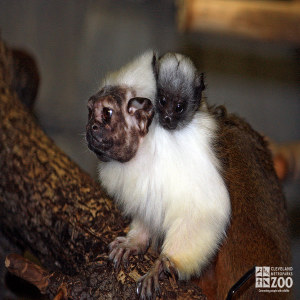Pied Tamarin
[Saguinus bicolor ]

In the pied tamarin, the forequarters are yellowish or white, sharply defined from the grayish-brown hindquarters. The mostly naked face is black, with the crown densely haired. Head and body length is from 6.9 to 12.2 inches; tail length from 9.8 to 15.7 inches; and weight from 7.94 to 31.7 ounces. The lower canine teeth are longer than the incisors.
Location: The RainForest Atrium
Share:
Range
The range of the pied tamarin is north of the Amazon River in north central Brazil.
Habitat
Pied tamarins inhabit Tropical forest, open woodland and secondary growth.
Conservation Status
EndangeredPrimary Threats
Human Wildlife CoexistenceGestation
140 days
Litter
2-Jan
Behavior
The pied tamarin is diurnal and arboreal, moving through trees with rather quick and jerky movements. An individual was observed to jump 49 feet from the top of a tree to the ground without injury. With the exception of some of the smaller prey, animals are killed by a bite on the head. Other than this there is no data available on behavior, either in the wild or in captivity.
Reproduction
In pied tamarins, as in other tamarins, the father assists at birth, receiving and washing the young. The newborn have a coat of short hair and are helpless. They cling tightly with their hands and feet to the body of the mother or father. The father transfers the young to the mother at feeding time, then accepts them again after feeding. This behavior takes place every 2 to 3 hours and lasts about half an hour. At about 21 days of age the young begin to explore nearby surroundings, but continue to ride on the backs of the parents until about 6-7 weeks of age. At 4 weeks they begin to accept soft food in addition to their mother's milk.
Wild Diet
Fruit, flowers, leaf buds, snails, small amphibians, plant gums and nectars

